Információk a Szakdolgozat, Diplomaterv készítéséhez és a Záróvizsga lebonyolításához
Akik a szakdolgozatot vagy diplomatervet a tanszéken szeretnék elkészíteni, a Neptun jelentkezés előtt kérjük, hogy személyesen egyeztessenek a tanszékvezetővel és a tanszéki konzulenssel!
A szakdolgozat és diplomaterv elkészítésével, valamint a záróvizsgával kapcsolatos információkat a Záróvizsga útmutató tartalmazza, amely letölthető a diplomaterv portálról. A Záróvizsga útmutató részletesen tartalmazza az elkészítendő dolgozattal kapcsolatos adminisztrációs teendőket, a formai követelményeket és az egyes határidőket.
Friss diplomatémák – 2021 őszére
Szakdolgozat – BSc
2 speed E-axle clutch investigation
Thesis extract
- Determination of different application fields of 2 speed E-axles
- Definition of necessary requirements/functions of 2 speed clutches in these applications
- Driver profile analysis based on existing models
- Evaulate different type of clutches (wet/dry, open/closed), collect pros/cons, define the limits of application. Considering of cost and efficiency is also necessary. Building criteria system, decision matrix
- The focus is to find the best clutch type for each application
- Example study must be showed (design with calculation of a chosen system, evaluation of results according to the predefined criteria system)
Supervisor: Lovas László
2 speed E-axle clutch actuation
Thesis extract
- Presentation of different clutch actuation systems
- Presentation of clutch actuation of an existing E-axle system
- Additional concepts for clutch actuation should be investigated (electromechanical, lockable free wheel bearing, …)
- For a dry normally open clutch a wear compensation is required. Different options for self adjusting wear compensation should be investigated
- Selection and realization of an actuation system with wear compensation
Supervisor: Lovas László
Testbed Simulation – Controller Implementation and its Effects on Measurement Response
Thesis extract
- Setting up 1D Model of simplified testbed(s) in AMESIM
- Including controllers on input and output side similar like real TB setup
- Simulate with already used controller settings UUT behavior and response
- Optimize controller paramter strategy including different loadpoints and load profiles
- Workflow creation for controller parameter settings
Supervisor: Lovas László
Methodology of structure borne noise to airborne noise conversion considering acoustic radiation efficiency
Thesis extract
- improve airborne noise calculation based on sound power
- correlation to excite acoustics simulation from various projects
Supervisor: Lovas László
Diploma – MSc
E-axle structural optimized ready for 3D printing
Thesis extract
- The main goal is to take an existing e-axle and optimizing it with a structural optimization tool. Parts like e-motor, inverter, gears and mounting points need to be taken as fixed
- In a first loop the optimization should show the required structure to cover all load cases
- In a second loop the assembly (including new possibilities due to 3D printing) as well as closing of open structure need to be evaluated
- Estimation of printing time as well as assembly time compared to the base axle
- Estimation of cost compared to the base axle
Supervisor: Lovas László
Transmission / E-Axle CAD methodology development
Thesis extract
- To fasten the design process a methodology for the main structure should be developed
- The methodology should include gears, actuation, housing, e-motor housing
- Definition of necessary input parameter list
- Creation of necessary templates
- Creation of necessary CAD structure with proper parameter system
- Creation of different models as first
- Interfaces should be established to the E-Motor simulation as well as to the gear simulation
Supervisor: Lovas László
Mechanika és Járműszerkezetek
Járműalkatrészek anyaga csillapítási mechanizmusának identifikációja
Reológiai modellek tanulmányozása. Anyagtulajdonságok modellezése. Csillapítási mechanizmus identifikációja Modellparaméterek identifikációja kísérleti vizsgálatok alapján. Reológiai modell és az alkatrész dinamikai jellemzőinek kapcsolata. Különleges (polimer) szerkezeti anyagokból gyártott alkatrészek dinamika modellezése kísérleti mérések alapján, modellparaméterek felhasználása a végeselemes modellezésben.
Bekapcsolódási szintek: TDK dolgozat, BSc szakdolgozat, MSc diploma, PhD kutatás
Témafelelős: Pápai Ferenc
Szerkezeti diagnosztika és monitoring
Szerkezeti károsodás detektálása, lokalizálása, jelleghatározása, parametrizálása (mértékének meghatározása), maradó élettartam becslése. Kísérleti mérési módszerek kifejlesztése. Identifikációs módszerek kidolgozása. Diagnosztikai és monitoring stratégiák kidolgozása.
Bekapcsolódási szintek: TDK dolgozat, BSc szakdolgozat, MSc diploma, PhD kutatás
Témafelelős: Pápai Ferenc
Közlekedési rendszereknél fellépő nemlineáris hullámjelenségek
Egymást követő járművek esetén a járműoszlop valamely elemének lassulása vagy felgyorsítása hullámszerűen végigterjed. A hatás terjedése a vezetők reakciójának modellezésétől függően okozhatja a járműveknek a közlekedési dugókra jellemző összetorlódását, amely bizonyos esetekben maga is terjed. Az ilyen jelenségek egy speciális nemlineáris hullámjelenség, a szoliton kvalitatív tulajdonságait mutatják. A kutatás célja a jelenség mélyebb megértése a esetleges forgalomszervezési megoldások érdekében.
Főbb területek:
- járműoszlopok mint dinamikai rendszerek,
- egyszerű vezető modell szerepe,
- rekurzív és anticipatív renszerek,
- nemlineáris jelenségek.
Bekapcsolódási szintek: TDK dolgozat, BSc szakdolgozat, MSc diploma, PhD kutatás
Témafelelős: Béda Péter
Nem-lokális anyagok mechanikai modellezése
A korszerű szerkezeti anyagok között egyre gyakrabban jelentkezik igény a nem-lokális tulajdonságokat is figyelembe vevő modellek alkalmazására. Ezek felépítése, kezelése és a szükséges kísérleti módszerek kidolgozása igen fontos feladat. A konkrét anyagok kompozitok, makromolekulás polimerek, nanotechnológiás anyagok: grafén, karbon nano-cső, stb. ahol fontos a nano-szerkezetek nem-lokális hatásainak modellezése.
Számtalan megközelítés, kutatási irány lehetséges, például:
- belső anyagi hossz, gradiens anyagok modellei,
- frakcionális kalkulus alkalmazása,
- térbeli, illetve időbeli nem-lokalitás vizsgálata,
- lineáris és nem-lineáris stabilitási problémák,
- diszkrét-kontinuum modell-átmenetek kezelése.
Bekapcsolódási szintek: TDK dolgozat, BSc szakdolgozat, MSc diploma, PhD kutatás
Témafelelős: Béda Péter
Biomechanikai kutatások
Combcsont, vagy lábszárcsont végeselemes vizsgálata
Combcsont, vagy lábszárcsont implantátumok készítéséhez feltétlenül szükséges annak méretezése mechanikai szempontból. Megfelelő pontosságú elemzéshez, a deformációk és feszültségmezők meghatározásához szükségesek a végeselemes szimulációk. Ezek elvégzéséhez ismerni kell az adott csontra ható igénybevételeket, annak beépítési környezetét, a csontok anyagjellemzőit. A szimulációhoz szükséges továbbá egy megfelelően kezelhető CAD modell is, aminek előállítása CT, stl modellek alapján szintén a feladat részét képezik.
Bekapcsolódási szintek: TDK dolgozat, BSc szakdolgozat, MSc diploma
Témafelelős: Ficzere Péter
3D nyomtatással kapcsolatos kutatások
Soft PLA anyagvizsgálat
A soft PLA filament különösen magas flexibilitással rendelkezik, valamint a guminál is puhább. Ideális tömítések és egyéb rugalmas alkatrészek nyomtatásához. Prémium minőségű PLA-Filament. A PLA egy minőségi bio-műanyag, melyet kukoricakeményítőből állítanak elő. Könnyű nyomtathatósága és a nyomtatott felület magas minősége miatt a legszélesebb körben elterjedt nyomtatóanyag FDM-nyomtatók számára. Nyomtatása teljesen szagtalan, fűtött platform nem szükséges hozzá.
Beépítéshez alkalmazáshoz célszerű az alkatrészeket méretezni. A kutatás témája a méretezéshez szükséges anyagtörvények, anyagjellemzők meghatározása különböző nyomtatási paraméterek (nyomtatási sebesség –hőmérséklet, rétegvastagság, stb.) esetén.
Bekapcsolódási szintek: TDK dolgozat, BSc szakdolgozat, MSc diploma
Témafelelős: Ficzere Péter
Colorfabb BronzeFill Filament alapanyag vizsgálata
Bronz adalékú nyomtatószál vizsgálata FDM technológiájú 3D nyomtatáshoz.
Cél az adott alapanyag esetén az ideális gyártási paraméterek meghatározása.
Egyszerűbb gazdaságossági számítások elvégzése, előnyök, hátrányok, lehetőségek feltárása.
Beépítéshez alkalmazáshoz célszerű az alkatrészeket méretezni. A kutatás témája a méretezéshez szükséges anyagtörvények, anyagjellemzők meghatározása különböző nyomtatási paraméterek (nyomtatási sebesség –hőmérséklet, rétegvastagság, stb.) esetén.
Bekapcsolódási szintek: TDK dolgozat, BSc szakdolgozat, MSc diploma
Témafelelős: Ficzere Péter
Condition Failure Monitoring – Algorithm Improvement and Failure Prediction Using AI and Machine Learning
Thesis extract
- Predict failure and UUT response based on already measured data
- Use of different AI and Machine Learning techniques
- Neural Net
- Support Vector Machine
- Hidden Markov Model
- Comparison of different prediction models
Supervisor: Lovas László
Condition Failure Monitoring – Simulation of Testbed Failures and its Response on Measurement Signals
Thesis extract
- Setting up 1D/3D model of simplified testbed in AMESIM/EXCITE
- Failure definition
- Isolation
- Bearings
- Magnets
- Failure modelling used to simulate effects dependant on their heaviness
- CFM signal post processing of simulation results taking a look how CFM will detect failure
Supervisor: Lovas László
Relation between gear microgeometry modification and transmission error torque sweep function + contact pattern
Thesis extract
How does the TE vs. torque function and contact pattern looks like due to different microgeometry modifications.
- Investigations on ideal case (only tooth stiffness)
- Investigation on real model: considering tooth, shaft, bearing, housing stiffness
- For both spur and helical gear.
Outcome: A know-how ‘database’, if the have to optimize TE for a specific torque level, to know what is the effect of which microgeometry modification (also for contact pattern)
Supervisor: Lovas László
Excite SBN results reproduction with Abaqus frequency domain solver + damping model development (emotor with higher damping, damping pads)
Thesis extract
- There is a limitation in Excite regarding to damping models
- In Abaqus frequency domain solver there is multiple solution to define Rayleigh or hysteresis damping for each component of housing structure
- Task is to find a way how to reproduce Excite results with Abaqus
- Then compare results with detailed damping modelling
Supervisor: Lovas László
Condition Failure Monitoring – Correlation of UUT & testbed failures and their response on measurement signals on the high speed testbed
Thesis extract
Using the high speed testbed for investigating the measurement signal response in case of purposely created/modelled UUT & testbed failures.
- Making a test case list about the purposely created failures/damages (gear damage, bearing damage, imbalance of shafts etc.)
- Supporting the execution of the test cases at the testbed
- Measurement post-processing and correlation to CFM results in order to see the response
- Added benefit/topic:
- Correlation of contact pattern results and any other 1D simulation results in case of purposely created operational cases → at least additional 3 months
Supervisor: Lovas László
Controller parameter study and investigation its signal response on the high speed testbed
Thesis extract
Using the high speed testbed for investigating the measurement signal response in case of a controller parameter study.
- Set up a controller parameter study
- Supporting the execution of the test cases at the testbed
- Measurement post-processing and correlation to CFM results in order to see the response
- Correlation to controller parameter simulation (linked to #9 – Thesis idea)
Supervisor: Lovas László
Measurement and processing of torque ripple results
Thesis extract
- Study effects playing role in ripple measurements
- Create tool or simulation model for evaluation and pre-calculation of effects taking into account mech. setup (clutches, dyno, position sensor, flywheel)
- Cooperation with testbed design
- Noise factors of cogging torque, torque ripple measurements: NVH, shaft connections, dyno etc.
- Optimization of a certain shaft connection and dyno type
- Investigation of various shaft connections → Possibilities, effects
Supervisor: Lovas László
Test bed design for >= 10 kW servo applications
Thesis extract
- Check applications which could be measured on a single test bed (same shafts, bearings, dyno etc) eg.: 2 WP, aviation (drone), eBike…
- Identify differences in requirements to usual eAxles
- Create test bed design
Supervisor: Lovas László
Inverter testing on EDU system level
Thesis extract
- Evaluation of test cases that can be executed
- High flexible usage of B2B test environments with climatic chambers
- HV / LV safety on system level (LV123 / LV124-1)
- Possible strategy:
- Understanding of various standards for various markets (EU, USA, China etc.) → Cooperation with DVP
- What’s next? Decide based on outcomes of customer projects
Supervisor: Lovas László
High accurate assessment of efficiency distribution in an electrified Driveline (e.g. DHT, EDU)
Thesis extract
- Test envirmonments and instrumentation (Piezo, magnetostrictive transducers, …)
- Measurement uncertainty of instrumentation (see also subject 7)
- Correlation to efficiency simulation tool
Supervisor: Lovas László



